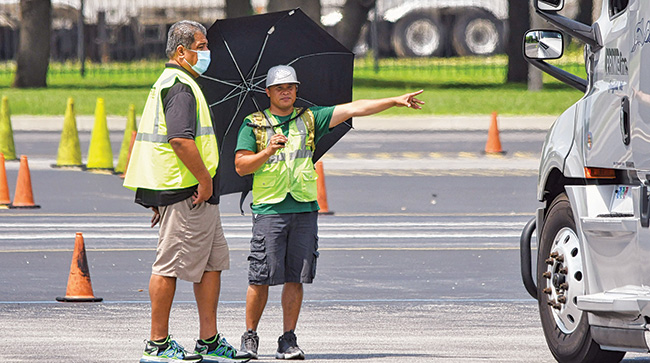Planning, Hydration Can Protect Truck Drivers During Heat Waves

[Stay on top of transportation news: Get TTNews in your inbox.]
As a series of extreme heat waves settled over large swaths of the country this summer, professional truck drivers were at times exposed to temperatures well over 100 degrees as they worked to deliver the nation’s freight.
These high temperatures are not merely a discomfort. They can also be dangerous, particularly if workers are not prepared.
When drivers are suddenly exposed to much higher temperatures and humidity during heat waves, their bodies may not have the opportunity to become acclimatized, said Dr. John Abraham, owner and medical director of Trinity Healthcare. The Missouri-based medical group is truckload carrier Prime Inc.’s occupational healthcare and wellness provider.
“There’s a fine line drivers must walk between moving freight within the allotted transit times and avoiding heat-related illness during heat waves,” Abraham said.
With more than 4,800 drivers and nearly 500 owner-operators, Prime Inc. helps drivers walk that line by providing them with education on proper hydration, and encouraging them to drink plenty of water and to avoid disruptions to their 10-hour downtime whenever possible.

Prime Inc. driving trainer Joey Bell (right) holds an umbrella to shield himself from the heat as he instructs student Patrick Penitani in a CDL course. (Prime Inc.)
Prime Inc., based in Springfield, Mo., ranks No. 18 on the Transport Topics Top 100 list of the largest for-hire carriers in North America.
“When temperatures spike, the primary concern is about the amount of fluid and water that’s in the driver’s system,” Abraham said. “Heat exhaustion and dehydration can cause organ failure and can even lead to death if allowed to go too far.”
According to the U.S. Department of Labor Occupational Safety and Health Administration, 50-70% of all outdoor fatalities occur in the first few days working in warm or hot environments because the body needs to build a tolerance to the heat gradually over time. The process of building tolerance is called heat acclimatization.

Abraham
When the body becomes acclimated to hot weather, it becomes more heat tolerant as a body can sweat 2-3 more liters per hour, Abraham explained. Sweat is how the body rids itself of excess heat. If that heat is not expelled, heat exhaustion sets in, he said.
Instead of focusing attention solely on temperatures, Abraham advises paying close attention to the heat index, which takes into account both temperature and humidity. It provides a more accurate picture of heat conditions and should be closely monitored during a heat wave, he added.
“The higher the heat index, the hotter the weather feels,” Abraham said. “That’s because with the higher humidity, the higher moisture content in the air doesn’t allow sweat to evaporate and cool the skin.”
Beating the Heat
Stephen Kane, president of Rolling Strong, a Kansas City, Mo.-based provider of driver wellness programs for transportation companies, said one key way for drivers to avoid heat-related illness is to concentrate on staying hydrated before they become thirsty.
“Because once you start to become dehydrated, it’s really tough to get back,” he said.
Drivers should also know what beverages to avoid, Kane said.

Kane
Energy drinks, while popular, may be a poor choice because of their amount of sugar and caffeine, he added. The best recommendations are water or hydration beverages that provide necessary minerals and salts that a body loses through sweating.
Kane also advises drivers to replace fast food by preparing lighter meals in advance featuring green leafy vegetables in addition to cucumbers and watermelon. When the body metabolizes large meals, the body temperature goes up.
Since adequate rest is also key to improving the body’s ability to handle heat stress, drivers and company dispatchers should be aware of how much sleep drivers actually need and adjust those activities accordingly, Kane said.
The mandatory 10-hour rest break can easily and quickly evaporate due to the various tasks drivers may need to complete, such as calling home and talking with family members, paying bills, completing correspondence and exercising (which can help drivers maintain their fitness to better handle heat stress).
Just as drivers must prepare for cold weather driving, drivers and fleets need to look at driving in the heat with the same degree of care and concern, Kane said.

Just as they must prepare for cold weather, drivers and fleets need to look at driving in the heat with the same degree of care and concern. (MCCAIG/Getty Images)
Rolling Strong’s wellness programs for drivers provide some ideas. For example, drivers can prepare by filling coolers with bottles of water and other forms of adequate and appropriate hydration. Other good items to fill those coolers include watered-down fruit juices and ready-to-eat pieces of watermelon, cucumber or other fruits or vegetables to consume during the day, he added.
For those drivers who consume coffee or other caffeinated beverages to maintain or augment their alertness level, Abraham recommends offsetting them with equal amounts of water. For every 8-ounce cup of coffee or 100 mg of caffeine consumed, drivers should drink an equivalent amount of water. This would be in addition to the recommended minimum daily intake of 90 ounces of water per day for women and 125 ounces per day for men, Abraham added.
If at any time drivers feel dry mouth, nausea, headaches, confusion or dizziness, they should stop immediately and notify their company dispatchers. Abraham said these could be signs and symptoms of dehydration or heat exhaustion.
Drivers suffering from dehydration should rehydrate with water and drinks such as Gatorade with electrolytes before getting back on the road or continuing activities such as pre- and post-trip inspections or cargo securement.
Scott Douglas, an instructor at the Sage Truck Driving School and a 19-year career truck driver, said he knows firsthand just how serious dehydration can be and how quickly it can become life-threatening.
“Having been dehydrated when I served in the military... [I] had to be taken to the hospital and have an IV put in my arm and two liters of saline solution pumped into me because I got dehydrated,” he said. “I know from experience just how fast that can hit you and how bad the results can be when it finally hits you.”

How much impact does driver pay have in hiring drivers? And what else can fleets do to recruit and retain quality talent? Hear a snippet from DriverReach founder and CEO Jeremy Reymer, above, and listen to the full program at RoadSigns.TTNews.com.
Douglas said he believes most trucking companies want drivers who will notify them when they aren’t able to complete scheduled deliveries or routine tasks such as inspections and loading freight because of concerns over heat-related illness.
Douglas noted that no matter the weather, outside work is unavoidable for truck drivers, but it’s best not to rush when beating the heat.
“If necessary, slow the whole process down a bit, pace yourself. You’re less likely to get excessively tired, or excessively sweaty, which of course leads to dehydration quicker,” he said. “Make sure that you’ve got some fluids [and] that you can take a couple-of-minute break here [and] there.”
Want more news? Listen to today's daily briefing below or go here for more info:




